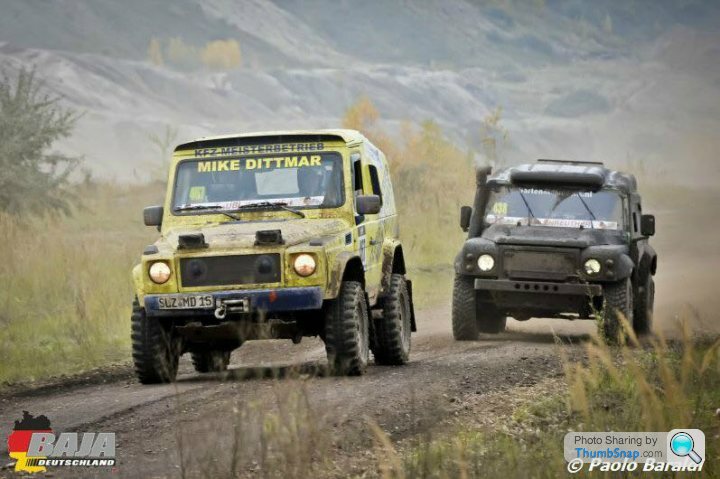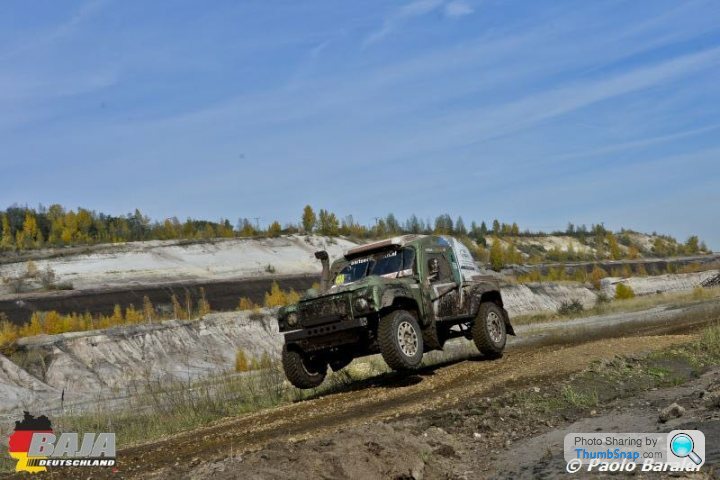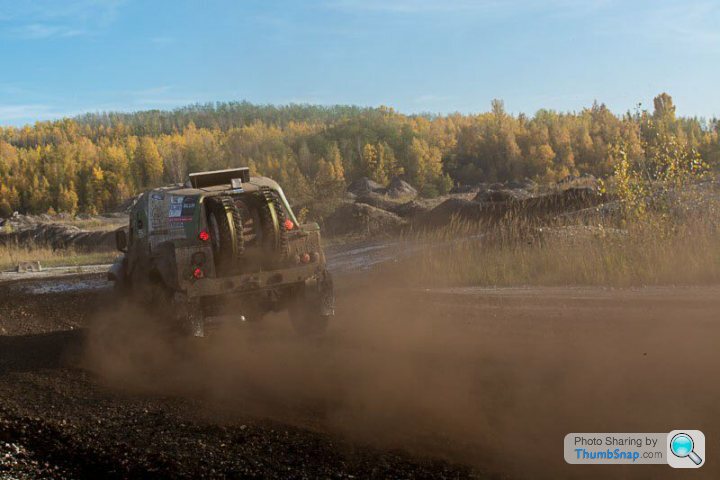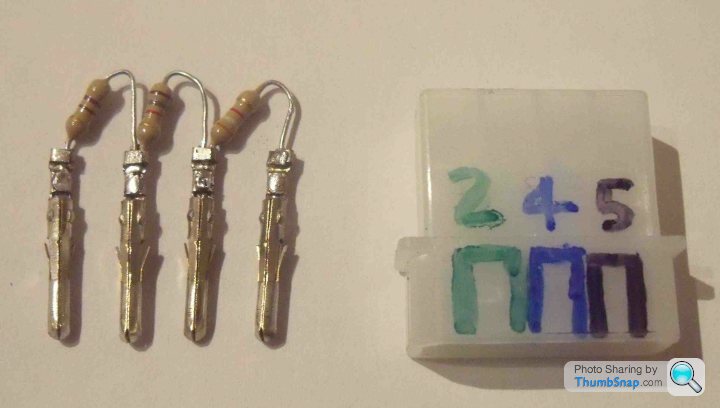Instructions to change fuel maps on 14CUX Griffith, Chimaera
Discussion
TomcatErik said:
I think i will go for our original map we made on the rolling road for the 3.9 as the heads inlet and exhaust are identical. After the first 300km of break-in we will go for the rolling road again. Hope to see 300bhp at the rear wheels.
The engine specs for the interested readers:
JE developments 5.15L crossbolted V8
Bore 94.5mm
Stroke 91.5mm
Conrods 5.700" centres
Pistons are forged Omega
Compression ratio: 10.0:1
Stage 3 heads (JE developments) fully ported
Inlet valve: 42.8mm
Exhaust valve: 36.2mm
Tvr plenum and trumpets
Tvr exhaust manifold with straight open pipe to the back (no silencers)
I will try to post some pics soon. Hopefully we'll have it up and running in two weeks. To cope with the torque we will upgrade the clutch to sintered bronze, to keep a bit of driveability we want to go for a custom hybrid clutch.
Once run in you’ll hopefully hit the bottom row of the fuel table too quickly until you change the AFM row scalar from B2 to 91, as you know. This change alone will make the AFR leaner until you increase the main multiplier/scalar as you’ll start using cells higher up the fuel table that have lower values. The AFM row scalar is a sliding scalar and therefore can be any value.The engine specs for the interested readers:
JE developments 5.15L crossbolted V8
Bore 94.5mm
Stroke 91.5mm
Conrods 5.700" centres
Pistons are forged Omega
Compression ratio: 10.0:1
Stage 3 heads (JE developments) fully ported
Inlet valve: 42.8mm
Exhaust valve: 36.2mm
Tvr plenum and trumpets
Tvr exhaust manifold with straight open pipe to the back (no silencers)
I will try to post some pics soon. Hopefully we'll have it up and running in two weeks. To cope with the torque we will upgrade the clutch to sintered bronze, to keep a bit of driveability we want to go for a custom hybrid clutch.
Nice engine spec, is that a small or large journal crank???
Here’s my current RPM table to 6250 rpm.
rpmTable DB $04, $B0, $40, $00 ; 6250 RPM Delta
DB $05, $94, $00, $12 ; 5250 RPM 1000
DB $06, $A8, $80, $F0 ; 4400 RPM 850
DB $07, $9C, $00, $10 ; 3850 RPM 550
DB $08, $9A, $80, $F6 ; 3405 RPM 445
DB $0A, $76, $80, $7F ; 2800 RPM 605
DB $0D, $F3, $80, $48 ; 2100 RPM 700 Offset $81B
DB $10, $BD, $80, $60 ; 1750 RPM 350
DB $14, $ED, $80, $3D ; 1400 RPM 350
DB $1A, $A2, $80, $2C ; 1100 RPM 300
DB $20, $8D, $80, $2B ; 900 RPM 200
DB $25, $8F, $80, $33 ; 780 RPM 120
DB $29, $DA, $80, $3B ; 700 RPM 80
DB $2F, $40, $80, $2F ; 620 RPM 80
DB $3D, $09, $80, $12 ; 480 RPM 140
DB $92, $7C, $40, $2F ; 200 RPM 280 Offset $83F (end)
Good Luck and enjoy
Steve
The crank is a large journal crank for a cross-bolted block. We are however still using the old oil pump and v-belts, so we are having a spacer made to fit the crank-shaft pulley on the longer nose. Here are a few pictures of the engine block, unfortunately I didn't take more pictures.
Short engine
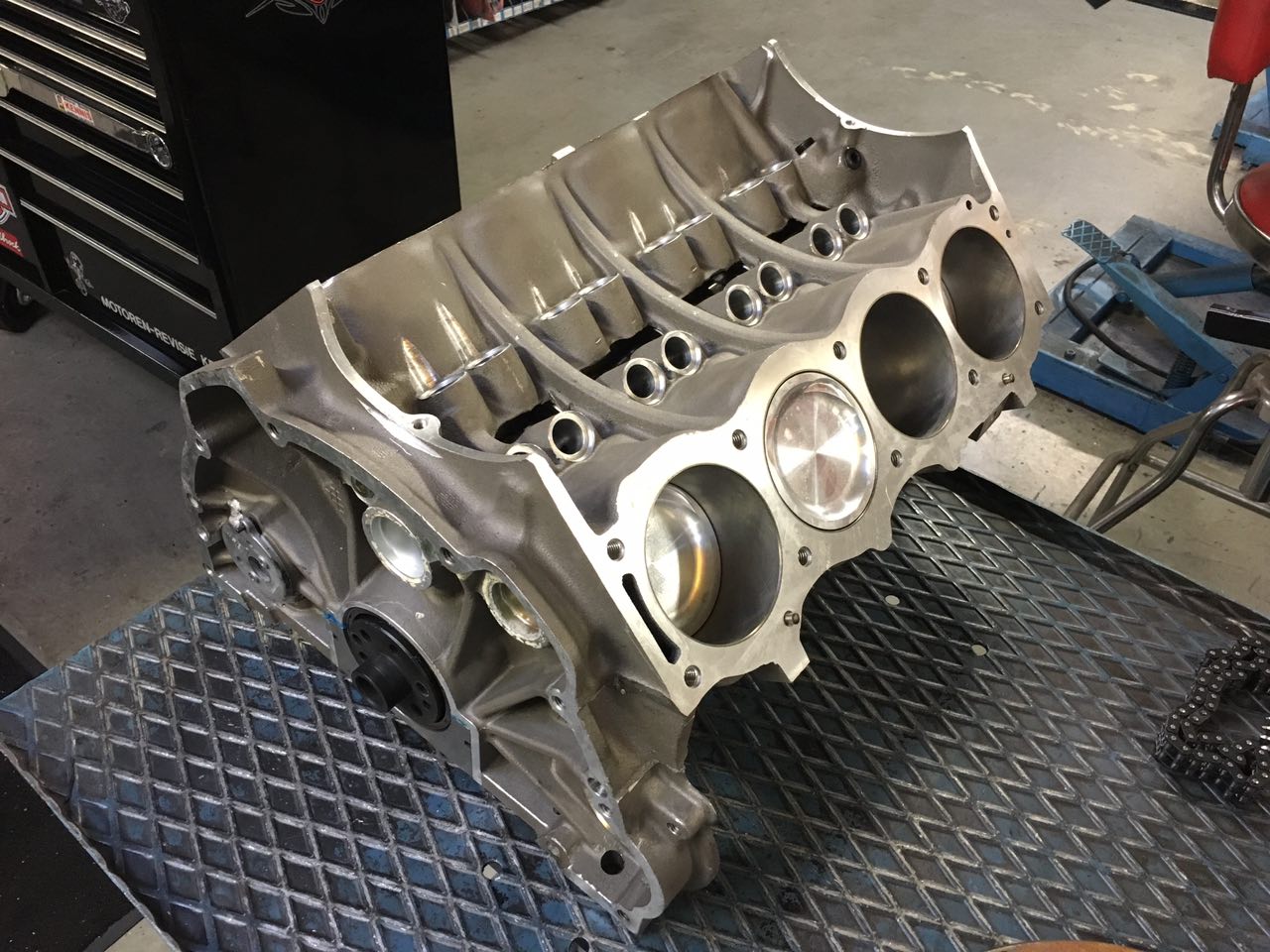
Piston
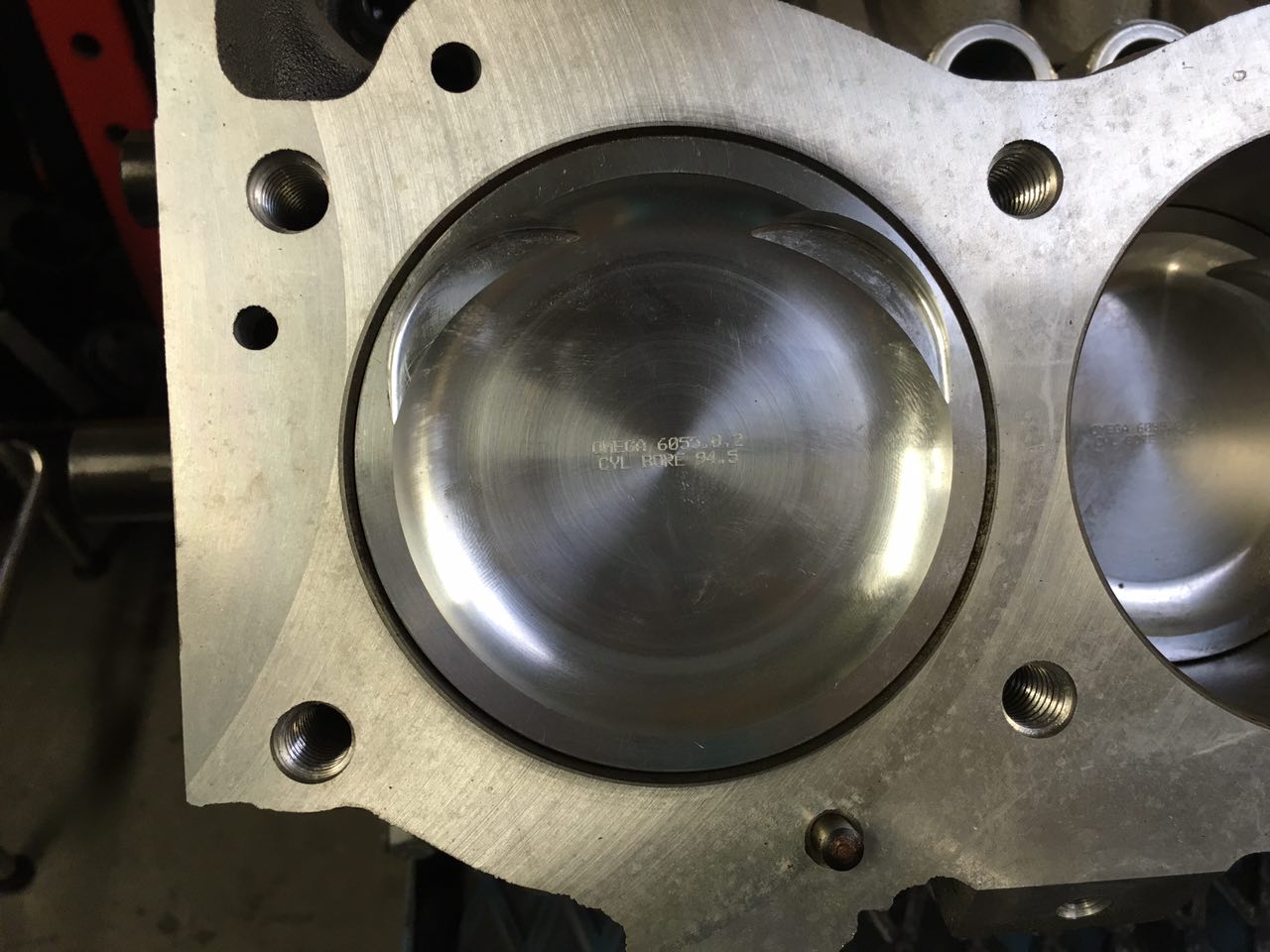
Assembled engine, looks just like a 3.9 again
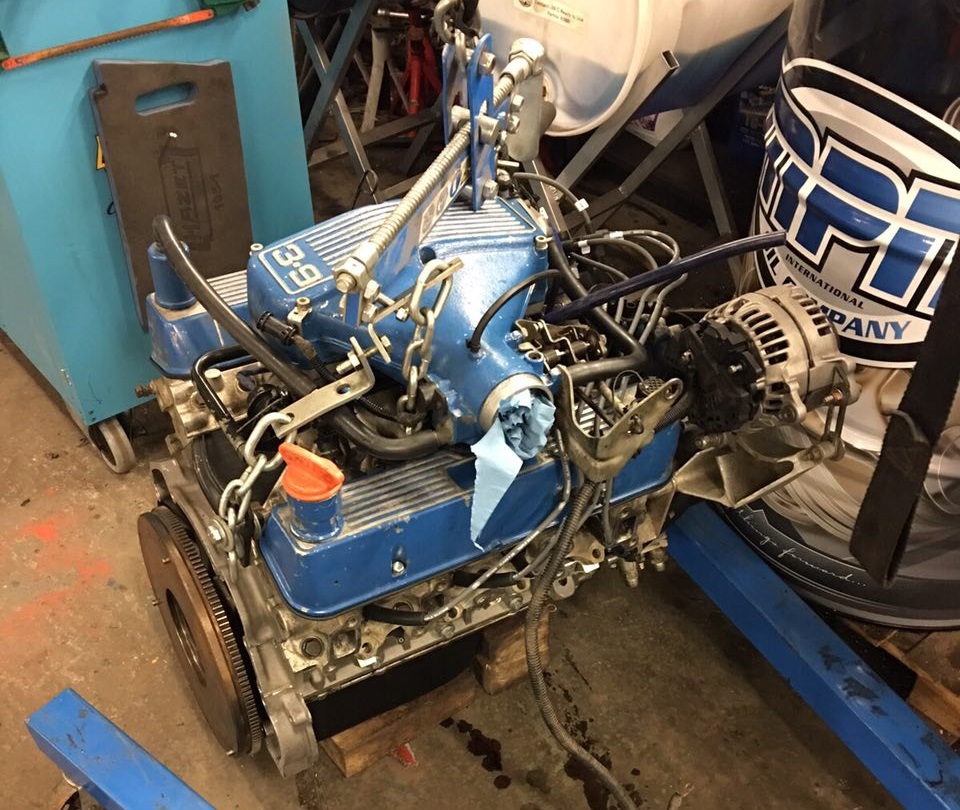
Short engine

Piston

Assembled engine, looks just like a 3.9 again

Griffian said:
stevesprint said:
If you buy a different Wideband sensor I’ll certainly try and help you merge your AFR log with RoveGauge but no guarantees I’ll make it work.
Thanks for the offer but I'm sure one of the ones you have already worked on will be fine. Griffian said:
Switchable firmware versions - a simple method
(plus Switchable tune resistor - a cheap and neat method)
Thanks for your very useful switchable firmware mod with clear instructions and I love your smart switchbox. If I didn't have a Moates Ostrich permanently wired in behind my battery I would definitely jump at the opportunity for switchable firmware.(plus Switchable tune resistor - a cheap and neat method)
Griffian said:
3) Carefully cut the square standoff pads off and cut notches near pins 1, 14 and 28 to allow wires to be soldered without preventing the socket from fully seating. Bend pin 1 gently outwards into the notch so it will not connect to the board socket. You may also want to cut it little shorter. Bend only once to avoid breaking it.
Please can we have a side view so I can see how you managed to solder onto pins 14 or 28. I like your idea to enable and disable the mil lamp so you know which firmware is running without firing up RoverGauge. In the past I've turn on and off the mil lamp in the code to help identify which code path is running while I was trying to get my head around the cold and lingering idle code.Griffian said:
I don't take credit for this idea. It's just recycled from the BBC micro days back in the 80s when we used to bend an EPROM leg so it hung out of the socket and solder a switchable wire directly to it (I still have some 27128 EPROMS in the loft!).
It's fascinating to learn the circuit board permanently holds the extra address line high and sounds like it's by design? It's a worry our ECU's technology dates back to the 1980's like the BBC Micros that I remember of as a kid. In fact, its very impressive how fast & powerful the old 14CUX's microprocessor is considering it dates back to the 1970's. At the time I could only afford a ZX81 and then a Dragon 32 that has a similar Motorla microprocessor (6809) which I struggled to teach myself assembler programming and that's why I'm so grateful to Dan and Dave.Griffian said:
Its brilliant you've noticed the old style computer hard drive power plugs fit the tune resistor socket and therefore can be modified to make a cheap and simple tune resistor/switch, I'll start recommending them to other people. Also thanks for informing us about the Aries Series 526 low profile ZIP socket as they look a much better option than my the load eject socket that I'm use to using, I'll have to get one.Griffian said:
I'm pleased to report that the TL866CS burner works perfectly under both 32-bit Windows 7 and 64-bit Windows 10. I've read a couple of 27C256 EPROMS and burned some 99p eBay 28C256 EEPROMS which read back fine and also work in the ECU.
Thanks for the update on your TL866CS chip programmer, I bought myself one for Christmas and can also now confirm it works a treat on 32 and 64-bit windows.DaveG said:
I have just experimented with Blue Tune resistor (1.8k - Cat), replacing the standard White (3.9k - Cat) and it has made an improvement, but 'light shunt' is still present. Can any of you clever RoverGuage experts expand on the difference between the Blue and the White Cat maps. Knowing the difference might well help me in what has become a desperate and exhausting quest!
Dave, I like your last nameThe blue fuel map 4 is the UK & Euro 4.2 Land Rover cat map, which the Griffith 500 chip still contains complete with the 4.2 fuel table & scalar of 6590 plus the 4.2 MAF scalar of B9. The Griff 500 fuel table scalar is 6784 and the AFM scalar is 91.
This mean when you selected map 4 (blue) you were actually running the 4.2 UK/Euro cat map and your 500 would hit the bottom of the fuel table too quickly as a 500 flows too much air for Land Rovers 4.2 MAF scalar. This actually means at shunting speed you might be using a cell slight lower down the fuel table which contains a higher value that potentially causes a richer mixture but maybe balanced out by the lower main scalar and the state of your lamba trims.
The problem is if you have to run the cat map any fuel table adjustments you make will just be corrected automatically by the lambda trims. However, it still might be useful to get your car on a rolling road to compare the shunting fuelling with both maps and identify the active fuel table cells in RoverGauge.
Griffian said:
Sorry to quote and then contradict my own reply, but after talk of radio interference etc., and looking at specs and prices, I'm quite interested in the Tech Edge logging units. Their 'budget' 2J9 unit seems to do all the right things, logs at a decent resolution and has a number of additional inputs (revs, speed, MAF/TPS etc.) The only tangible accuracy compromise seems to be the analogue output resolution which I don't plan to use. Ordered direct from Australia it's pretty reasonably priced even if you end up paying 20% VAT because the A$ is about 2:1. They also have a small, cheap DIY LED display LD02B which would suit my temporary gauging requirements. I think I can manage to do the necessary data merging myself but does anyone have any experience of their products?
You're right to avoid the LC-2 (Wideband control) if you're concerned about radio interference as its terrible and I've resorted to installing 2 huge 12v noise suppressors and it's still not as good as before. I might consider moving or renewing the radio aerial.I've just read the 2J9 Tech Edge logging unit spec and can understand why you're considering one especially as it can log AFR, RPM, TPS, MAF & VSS all together, nice. Although the 14CUX MAF output is not liner I'm sure you'll soon see and learn how its output voltage correlates to the fuel table row number. The only other minor concern is the code compensates for sudden throttle movements but isn't really an issue as I've now learnt to gradually ease off and on the throttle while logging.
stevesprint said:
I've just read the 2J9 Tech Edge logging unit spec and can understand why you're considering one especially as it can log AFR, RPM, TPS, MAF & VSS all together, nice.
It does look good. After a bit more research, the other minor negatives to this 'budget' unit are:- The processor is a little slower than on their premium products so may have a slower sampling rate. I expect it will still be much faster than the 14CUX though.
- The VSS input probably won't have the ideal resolution for multiple pulses per wheel revolution. It would work better with an additional sensor or some kind of electronic waveform divider.
- It requires initial free-air calibration when a new sensor is used as it doesn't use the manufacturer's calibration resistor.
Edited by Griffian on Tuesday 12th January 08:46
stevesprint said:
Griffian said:
3) Carefully cut the square standoff pads off and cut notches near pins 1, 14 and 28 to allow wires to be soldered without preventing the socket from fully seating. Bend pin 1 gently outwards into the notch so it will not connect to the board socket. You may also want to cut it little shorter. Bend only once to avoid breaking it.
Please can we have a side view so I can see how you managed to solder onto pins 14 or 28.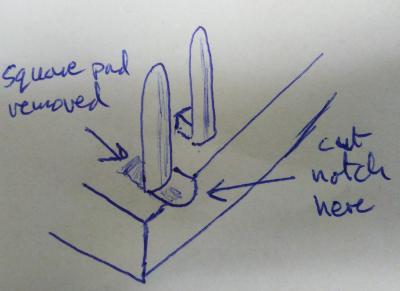
The bent pin only needs the notch, but the other two need the square standoff pad cut off too. It's more obvious when you see the actual socket. The idea is that the standoff gives space to loop a wire around the pin before soldering, and the notch leaves room for the insulation or the bent pin itself.
stevesprint said:
Griffian said:
Its brilliant you've noticed the old style computer hard drive power plugs fit the tune resistor socket and therefore can be modified to make a cheap and simple tune resistor/switch, I'll start recommending them to other people.Griffian said:
It does look good. After a bit more research, the other minor negatives to this 'budget' unit are:
After speaking to them and getting a very helpful email reply to some techie questions, I'm happy that it probably does what I need. They don't currently have the Bosch 4.9 sensors in stock, but as they are a better price than I can find locally it's my intention to buy the 2J9 controller and LD02B DIY LED display once they are.- The processor is a little slower than on their premium products so may have a slower sampling rate. I expect it will still be much faster than the 14CUX though.
- The VSS input probably won't have the ideal resolution for multiple pulses per wheel revolution. It would work better with an additional sensor or some kind of electronic waveform divider.
- It requires initial free-air calibration when a new sensor is used as it doesn't use the manufacturer's calibration resistor.
spitfire4v8 said:
Hi Griffian I have emailed you through your profile, the multi map switching is very interesting but i have a question not lucas related .. sorry for the little thread hijack peeps. as you were 
I haven't received an email. I also sent you one via PH profile but received no reply so I assume they're getting lost. Alternative contact method wthout disclosing address publicly is via the contact form at http://sakmc.org/contact-us
Griffian said:
I haven't received an email. I also sent you one via PH profile but received no reply so I assume they're getting lost. Alternative contact method wthout disclosing address publicly is via the contact form at http://sakmc.org/contact-us
Here's Jools (spitfire4v8) contact detailshttp://www.kitsandclassics.co.uk/workshop-contact-...
I have three more questions to the experts of the 14CUX injection system.
1) After reading the book on power tuning the rover V8 I decided to change the thermostat to a 74-78C. As a result the nominal engine temperature is now 77C as read with rovergauge. What should I edit in the cold-start enrichment table to prevent enrichment above 74C?
2) At the moment, no speedo signal is connected to the ECU. What are the adverse effects, other than a MIL light for speedo sensor error?
3) I'm still having a problem with the idle control. I cleaned the IACV by disassembling it, cleaning it and reassembling it with a bit of WD40. After starting the idle control works fine. However, after bit of driving the stepper drifts away to fully open with the ECY thinking it is closed. Changing to another used and cleaned unit gives the same problem.
For the idle control, could we change the code to allow some degree of "overstepping" to always have idle control. Also when the stepper is not in perfect condition.
For the speedo signal, we have a TD5 transfer box with the original 3-wire TD5 speed transducer. This transducer gives an output of 0V to 12V (battery voltage) square wave. Can I connect this directly to the ECU or do I need to bring the signal down to 5V?
1) After reading the book on power tuning the rover V8 I decided to change the thermostat to a 74-78C. As a result the nominal engine temperature is now 77C as read with rovergauge. What should I edit in the cold-start enrichment table to prevent enrichment above 74C?
2) At the moment, no speedo signal is connected to the ECU. What are the adverse effects, other than a MIL light for speedo sensor error?
3) I'm still having a problem with the idle control. I cleaned the IACV by disassembling it, cleaning it and reassembling it with a bit of WD40. After starting the idle control works fine. However, after bit of driving the stepper drifts away to fully open with the ECY thinking it is closed. Changing to another used and cleaned unit gives the same problem.
For the idle control, could we change the code to allow some degree of "overstepping" to always have idle control. Also when the stepper is not in perfect condition.
For the speedo signal, we have a TD5 transfer box with the original 3-wire TD5 speed transducer. This transducer gives an output of 0V to 12V (battery voltage) square wave. Can I connect this directly to the ECU or do I need to bring the signal down to 5V?
Edited by TomcatErik on Monday 18th January 09:27
I can answer 2 of these. The speed inputs needs to be a square wave 12 volt signal, switching 6 times per wheel revolution. Its used for idle control and also a top speed limit on the 4x4 map, that is programmable in the Eprom. I expect your idle speed issues are the fact the ECU cannot determine if you are moving or stationary with the lack of speedo pulse, so its stepper control will be unstable, as it has different idle requirements when the car is moving to reduce engine breaking between gears. In terms of its pulse rate, its not fussy, so as long as there is no speed pulse when the car is stationary the it should go into idle mode. If the Eprom has not been altered to disable the speed limit, then a high pulse rate could trigger an early top speed limit.
For those interested I have generated the full table from ADC counts (decimal and hex) to coolant temperature (both F and C).
ADC Hex F C
0 0 288,43 142,46
1 1 284,18 140,10
2 2 280,04 137,80
3 3 276,00 135,56
4 4 272,06 133,37
5 5 268,23 131,24
6 6 264,48 129,16
7 7 260,83 127,13
8 8 257,26 125,15
9 9 253,78 123,21
10 A 250,38 121,32
11 B 247,06 119,48
12 C 243,82 117,68
13 D 240,65 115,92
14 E 237,55 114,20
15 F 234,52 112,51
16 10 231,56 110,87
17 11 228,66 109,26
18 12 225,83 107,68
19 13 223,05 106,14
20 14 220,34 104,63
21 15 217,68 103,16
22 16 215,08 101,71
23 17 212,53 100,30
24 18 210,04 98,91
25 19 207,59 97,55
26 1A 205,19 96,22
27 1B 202,84 94,91
28 1C 200,54 93,63
29 1D 198,29 92,38
30 1E 196,07 91,15
31 1F 193,90 89,94
32 20 191,77 88,76
33 21 189,68 87,60
34 22 187,63 86,46
35 23 185,62 85,34
36 24 183,64 84,24
37 25 181,70 83,17
38 26 179,79 82,11
39 27 177,92 81,07
40 28 176,09 80,05
41 29 174,28 79,04
42 2A 172,50 78,06
43 2B 170,76 77,09
44 2C 169,05 76,14
45 2D 167,36 75,20
46 2E 165,70 74,28
47 2F 164,07 73,37
48 30 162,47 72,48
49 31 160,89 71,61
50 32 159,34 70,75
51 33 157,82 69,90
52 34 156,31 69,06
53 35 154,84 68,24
54 36 153,38 67,43
55 37 151,95 66,64
56 38 150,54 65,85
57 39 149,15 65,08
58 3A 147,78 64,32
59 3B 146,43 63,57
60 3C 145,10 62,83
61 3D 143,79 62,10
62 3E 142,50 61,39
63 3F 141,22 60,68
64 40 139,97 59,98
65 41 138,73 59,30
66 42 137,51 58,62
67 43 136,31 57,95
68 44 135,12 57,29
69 45 133,95 56,64
70 46 132,79 56,00
71 47 131,65 55,36
72 48 130,53 54,74
73 49 129,42 54,12
74 4A 128,32 53,51
75 4B 127,23 52,91
76 4C 126,16 52,31
77 4D 125,11 51,73
78 4E 124,06 51,15
79 4F 123,03 50,57
80 50 122,01 50,00
81 51 121,00 49,44
82 52 120,00 48,89
83 53 119,02 48,34
84 54 118,04 47,80
85 55 117,08 47,27
86 56 116,12 46,74
87 57 115,18 46,21
88 58 114,25 45,69
89 59 113,32 45,18
90 5A 112,41 44,67
91 5B 111,50 44,17
92 5C 110,61 43,67
93 5D 109,72 43,18
94 5E 108,84 42,69
95 5F 107,97 42,20
96 60 107,11 41,73
97 61 106,25 41,25
98 62 105,40 40,78
99 63 104,56 40,31
100 64 103,73 39,85
101 65 102,90 39,39
102 66 102,08 38,93
103 67 101,27 38,48
104 68 100,46 38,03
105 69 99,66 37,59
106 6A 98,87 37,15
107 6B 98,08 36,71
108 6C 97,30 36,28
109 6D 96,52 35,84
110 6E 95,75 35,41
111 6F 94,98 34,99
112 70 94,22 34,56
113 71 93,46 34,14
114 72 92,71 33,73
115 73 91,96 33,31
116 74 91,21 32,90
117 75 90,47 32,48
118 76 89,73 32,07
119 77 89,00 31,67
120 78 88,27 31,26
121 79 87,55 30,86
122 7A 86,82 30,46
123 7B 86,10 30,06
124 7C 85,39 29,66
125 7D 84,67 29,26
126 7E 83,96 28,87
127 7F 83,25 28,47
128 80 82,55 28,08
129 81 81,84 27,69
130 82 81,14 27,30
131 83 80,44 26,91
132 84 79,74 26,52
133 85 79,05 26,14
134 86 78,35 25,75
135 87 77,66 25,37
136 88 76,96 24,98
137 89 76,27 24,60
138 8A 75,58 24,21
139 8B 74,89 23,83
140 8C 74,20 23,45
141 8D 73,51 23,06
142 8E 72,83 22,68
143 8F 72,14 22,30
144 90 71,45 21,92
145 91 70,76 21,53
146 92 70,07 21,15
147 93 69,38 20,77
148 94 68,69 20,38
149 95 68,00 20,00
150 96 67,31 19,62
151 97 66,62 19,23
152 98 65,93 18,85
153 99 65,23 18,46
154 9A 64,53 18,07
155 9B 63,84 17,69
156 9C 63,14 17,30
157 9D 62,44 16,91
158 9E 61,74 16,52
159 9F 61,03 16,13
160 A0 60,32 15,74
161 A1 59,61 15,34
162 A2 58,90 14,95
163 A3 58,19 14,55
164 A4 57,47 14,15
165 A5 56,75 13,75
166 A6 56,02 13,35
167 A7 55,30 12,94
168 A8 54,57 12,54
169 A9 53,83 12,13
170 AA 53,09 11,72
171 AB 52,35 11,31
172 AC 51,61 10,89
173 AD 50,86 10,48
174 AE 50,10 10,06
175 AF 49,34 9,63
176 B0 48,58 9,21
177 B1 47,81 8,78
178 B2 47,03 8,35
179 B3 46,25 7,92
180 B4 45,47 7,48
181 B5 44,68 7,04
182 B6 43,88 6,60
183 B7 43,08 6,15
184 B8 42,27 5,70
185 B9 41,45 5,25
186 BA 40,63 4,80
187 BB 39,80 4,33
188 BC 38,97 3,87
189 BD 38,12 3,40
190 BE 37,27 2,93
191 BF 36,41 2,45
192 C0 35,55 1,97
193 C1 34,67 1,48
194 C2 33,79 0,99
195 C3 32,90 0,50
196 C4 32,00 0,00
197 C5 31,09 -0,51
198 C6 30,17 -1,02
199 C7 29,24 -1,53
200 C8 28,31 -2,05
201 C9 27,36 -2,58
202 CA 26,40 -3,11
203 CB 25,43 -3,65
204 CC 24,45 -4,19
205 CD 23,46 -4,74
206 CE 22,46 -5,30
207 CF 21,45 -5,86
208 D0 20,42 -6,43
209 D1 19,38 -7,01
210 D2 18,33 -7,59
211 D3 17,27 -8,18
212 D4 16,19 -8,78
213 D5 15,10 -9,39
214 D6 14,00 -10,00
215 D7 12,88 -10,62
216 D8 11,75 -11,25
217 D9 10,60 -11,89
218 DA 9,44 -12,53
219 DB 8,26 -13,19
220 DC 7,07 -13,85
221 DD 5,86 -14,52
222 DE 4,63 -15,21
223 DF 3,38 -15,90
224 E0 2,12 -16,60
225 E1 0,84 -17,31
226 E2 -0,46 -18,03
227 E3 -1,78 -18,77
228 E4 -3,12 -19,51
229 E5 -4,47 -20,26
230 E6 -5,85 -21,03
231 E7 -7,25 -21,81
232 E8 -8,68 -22,60
233 E9 -10,12 -23,40
234 EA -11,59 -24,21
235 EB -13,08 -25,04
236 EC -14,59 -25,88
237 ED -16,13 -26,74
238 EE -17,69 -27,61
239 EF -19,28 -28,49
240 F0 -20,90 -29,39
241 F1 -22,54 -30,30
242 F2 -24,21 -31,23
243 F3 -25,91 -32,17
244 F4 -27,64 -33,13
245 F5 -29,40 -34,11
246 F6 -31,19 -35,10
247 F7 -33,01 -36,12
248 F8 -34,86 -37,15
249 F9 -36,75 -38,20
250 FA -38,67 -39,26
251 FB -40,63 -40,35
252 FC -42,63 -41,46
253 FD -44,66 -42,59
254 FE -46,73 -43,74
255 FF -48,84 -44,91
I tried to search the thread but google was not very helpful, therefore I missed your post. I used the curve fitting function from the 14cux lib of Colin to calculate the values. What is the correct one that should be used? I was assuming the 14CUX ECU only uses the raw ADC values so the truth might be in the middle.
Gassing Station | Griffith | Top of Page | What's New | My Stuff




